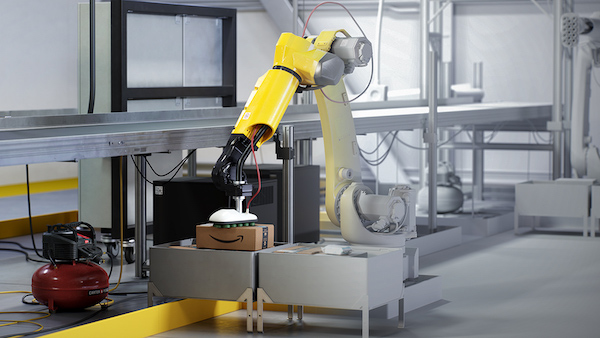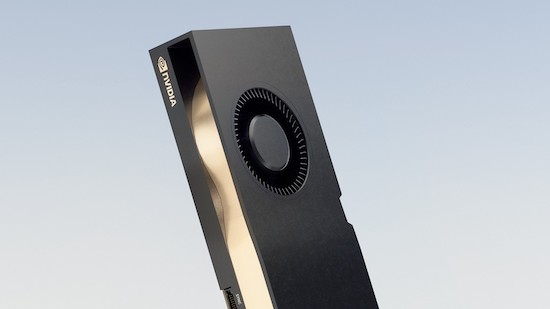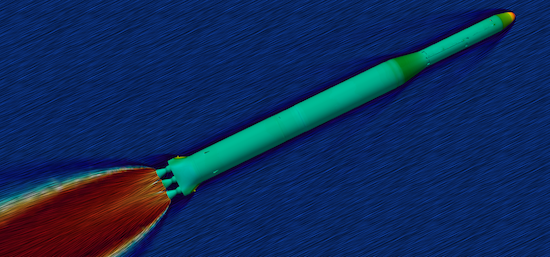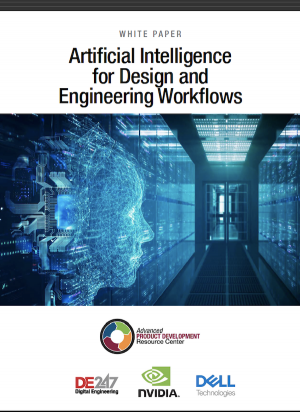RTX Power for Laptops, Digital Twin Innovations Highlight GTC 2022
New workstation GPUs and NVIDIA Omniverse updates lead the announcements at the NVIDIA GTC 2022 Spring virtual conference

Amazon is leveraging NVIDIA Omniverse to optimize its distribution center robotics systems. Image courtesy of NVIDIA.
Latest News
March 25, 2022
NVIDIA announced a slew of new products and capabilities at the NVIDIA GTC Conference on March 22nd. The company further expanded its RTXGPU offerings for desktops and mobile workstations and has expanded its NVIDIA Omniverse Enterprise platform to enable innovative digital twin and artificial intelligence (AI) applications..
For engineering workstation users, the big news was the announcement of seven new powerful GPUs for both desktop and mobile computers. For mobile users in particular, the new GPUs present an opportunity to increase rendering and simulation performance according to a company blog by Bob Pette, NVIDIA VP/GM, Professional Visualization:
“The new NVIDIA RTX™ A500, NVIDIA RTX™ A1000, NVIDIA RTX™ A2000 8GB, NVIDIA RTX™ A3000 12GB, NVIDIA RTX™ A4500 and NVIDIA RTX™ A5500 laptop GPUs expand access to AI and ray-tracing technology, delivering breakthrough performance no matter where you work. The laptops include the latest RTX and Max-Q technology, giving professionals the ability to take their workflows to the next level.”

For desktop users, the new NVIDIA RTX A5500 desktop GPU combines RT Cores, Tensor Cores and CUDA cores with 24G of memory, providing ray-traced rendering that is 2x faster than previous generation chips, and motion blur rendering performance up to 9x faster.
Aerospace engineering firm M4 Engineering is already using the new RTX A5500.
“The multi-app product development workflows we use at M4 are well-served by the NVIDIA RTX A5500 and its 24GB of memory,” said Brian Rotty, senior engineer at M4 Engineering. “My team can handle larger CAD and CAE datasets than before and, critically, we can interact with and iterate these larger datasets simultaneously by making use of the extra GPU memory headroom and compute capabilities of this new card.”

The new GPUs include optimizations to power NVIDIA Omniverse Enterprise, as well as NVIDIA AI-enabled tools like NVIDIA Broadcast and Canvas. The laptop GPUs include 2nd gen RT Cores, 3rd gen Tensor Cores and NVIDIA Ampere architecture streaming multiprocessor .
The laptop GPUs also include Max-Q technology, an AI-based system optimization solution that provides quieter and more efficient performance, as well as up to 16GB of GPU memory. The A2000, A3000 and A4500 feature twice the memory of previous-generation GPUs.
OEM partners like Dell Technologies will offer workstations with the RTX A5500 and the new laptop GPUs beginning this spring.
In addition, the company also announced new data center GPU products. Those include the NVIDIA Grace™ CPU Superchip (which includes two CPU chips connected over NVLink-C2C) and the NVIDIA H100 GPU (the first based on the new NVIDIA Hopper™ architecture). These developments are centered on artificial intelligence acceleration, and the company also announced the NVIDIA Eos Supercomputer, which is expected to be the world's fastest AI system. The AI and data science capabilities enabled by these new data center and supercomputing solutions will be critical for solving complex design challenges and developing new systems like autonomous vehicles.
NVIDIA Omniverse Enterprise and Digital Twin Innovations
There were also a number of big announcements related to Omniverse Enterprise, the 3D design collaboration and digital twin simulation platform NVIDIA has developed. Many of these developments announced at this GTC centered on digital twin and artificial intelligence applications of the platform. (Lockheed Martin is leveraging Omniverse Enterprise for a digital twin application, which they discussed in this GTC session.)
The Omniverse ecosystem has expanded with new connections and libraries for third-party applications. New CAD importers convert 26 common CAD formats to Universal Scene Description (USD), and there are new connections for Adobe Substance 3D Materials and 3D Painter (coming soon), as well as Epic Games Unreal Engine and Maxon Cinema 4D. Omniverse users will also be able to integrate their favoriteHydra delegate-supported renderers into Omniverse Apps to use in addition to the Omniverse RTX Renderer.. Initial integrations are now in beta for Chaos V-Ray, , withBlender Cycles, Maxon Redshift, OTOY Octane and Autodesk Arnold on the way.
Bentley Systems also announced the availability of LumenRT for NVIDIA Omniverse, powered by Bentley iTwin, a step towards a new class of digital twin simulation for infrastructure and design use cases.
NVIDIA also announced the new NVIDIAⓇ OVX™Omniverse computing system designed to power large-scale digital twins. It combines high-performance GPU-accelerated compute, graphics and AI with high-speed storage access and low-latency networking. According to NVIDIA, “OVX will enable designers, engineers, and planners to build physically accurate digital twins of buildings or create massive, true-to-reality simulated environments with precise time synchronization across physical and virtual worlds.”
“We worked with customers to build something from the ground up dedicated to supporting these industrial-scale digital twin applications,” said Bob Pette.
During the keynote, NVIDIA CEO Jensen Huang also discussed several new Omniverse Enterprise customer examples. Amazon Robotics is using Omniverse Enterprise and Isaac Sim to create digital twins of its distribution centers to optimize flow, as well as to train its intelligent robotics solutions.
Grocery chain Kroger Co. is using NVIDIA AI Enterprise and Omniverse Enterprise and software suites to build digital twin simulations of its stores to improve operations. Lowe's Innovation Labs is leveraging Omniverse for a similar project to optimize its own store operations.
Siemens Gamesa Renewable Energy is also working with NVIDIA to create physics-informed digital twins of its wind farms. The digital twins will be built using Omniverse Enterprise and NVIDIA Modulus. According to NVIDIA, the platform will help Siemens Gamesa achieve quicker calculations to optimize wind farm layouts, which is expected to lead to farms capable of producing more power than previous designs.
In addition, Omniverse Enterprise is now available via NVIDIA LaunchPad, which gives designers and project reviewers free turnkey access to hands-on, curated Omniverse Enterprise labs.
You can learn more about the NVIDIA GTC announcements and sessions here.
More Dell Coverage

More NVIDIA Coverage
Subscribe to our FREE magazine, FREE email newsletters or both!
Latest News
Related Topics








